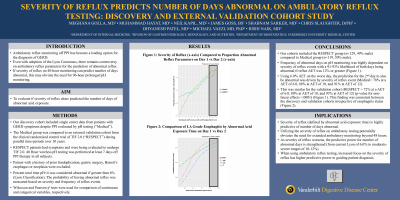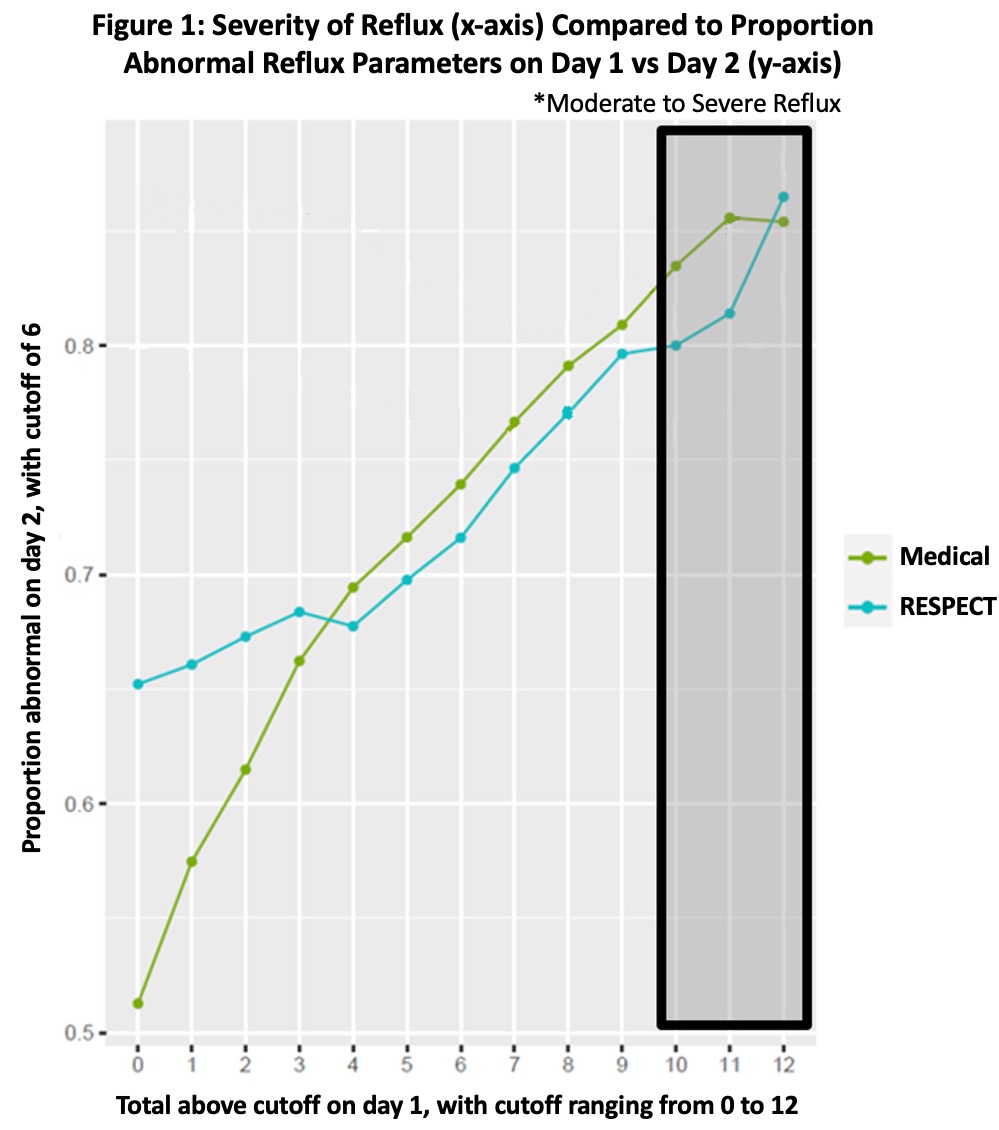Back


Poster Session D - Tuesday Morning
Category: Esophagus
D0193 - Severity of Reflux Predicts Number of Days Abnormal on Ambulatory Reflux Testing: Discovery and External Validation Cohort Study
Tuesday, October 25, 2022
10:00 AM – 12:00 PM ET
Location: Crown Ballroom

Has Audio

Meghana Golla, MD
Vanderbilt University Medical Center
Nashville, TN
Presenting Author(s)
Meghana Golla, MD1, Muhammad Hashim Hayat, MD1, Neil Kapil, MD1, James Goss, BS2, Shabnam Sarker, MD1, James Slaughter, PhD2, Dhyanesh Patel, MD1, Michael F. Vaezi, MD1, Rishi D. Naik, MD, MSCI1
1Vanderbilt University Medical Center, Nashville, TN; 2Vanderbilt University, Nashville, TN
Introduction: Ambulatory reflux monitoring off PPI has become a leading option for the diagnosis of GERD. Even with adoption of the Lyon Consensus, there remains controversy on ambulatory reflux parameters for the prediction of abnormal reflux. The aim of our study was to evaluate if severity of reflux alone predicted the number of days of abnormal acid exposure.
Methods: Our discovery cohort included single center data from patients with GERD symptoms despite PPI evaluated by pH testing (“Medical”). The Medical group was compared to an external validation cohort from the clinical RCT trial of TIF 2.0 (“RESPECT”) during parallel time-periods over 10 years. RESPECT patients had symptoms and were being evaluated to undergo TIF 2.0. 48 Hour wireless pH testing was performed at least 7 days off PPI therapy in all subjects. Percent total time pH< 4 was considered abnormal if greater than 6% (Lyon Classification). The probability of having abnormal reflux was measured based on severity and frequency of reflux events. Wilcoxon and Pearson X2 tests were used for comparison of continuous and categorical variables, respectively.
Results: Our cohorts included the RESPECT group (n=129, 49% male) compared to Medical group (n=119, 30% male). Frequency of abnormal days on pH monitoring was highly dependent on severity of reflux events with a 91-93% likelihood of both days being abnormal if reflux AET was 12% or greater (Figure 1). Using 6.0% AET on the worst day, the prediction for the 2nd day to also be abnormal was driven by severity of reflux event (Medical= 78% at a pH of 6.0, 88% at pH of 10, and 91% at pH of 12). This was similar for the validation cohort (RESPECT = 72% at a pH of 6.0, 80% at pH of 10, and 93% at pH of 12) (p-value for non-linear effects < .0001) (Figure 1). This finding was consistent between the discovery and validation cohorts irrespective of esophagitis status.
Discussion: Severity of reflux (defined by abnormal acid exposure time) is highly predictive of number of days abnormal. Utilizing the severity of reflux on ambulatory testing potentially obviates the need for extended ambulatory monitoring beyond 48 hours. As severity of reflux worsens, the predictive power for number of abnormal days is strengthened (from current Lyon of 6.0% to moderate-severe ranges of 10-12). When using ambulatory reflux testing, increased focus on the severity of reflux has higher predictive power in guiding patient diagnosis.

Disclosures:
Meghana Golla, MD1, Muhammad Hashim Hayat, MD1, Neil Kapil, MD1, James Goss, BS2, Shabnam Sarker, MD1, James Slaughter, PhD2, Dhyanesh Patel, MD1, Michael F. Vaezi, MD1, Rishi D. Naik, MD, MSCI1. D0193 - Severity of Reflux Predicts Number of Days Abnormal on Ambulatory Reflux Testing: Discovery and External Validation Cohort Study, ACG 2022 Annual Scientific Meeting Abstracts. Charlotte, NC: American College of Gastroenterology.
1Vanderbilt University Medical Center, Nashville, TN; 2Vanderbilt University, Nashville, TN
Introduction: Ambulatory reflux monitoring off PPI has become a leading option for the diagnosis of GERD. Even with adoption of the Lyon Consensus, there remains controversy on ambulatory reflux parameters for the prediction of abnormal reflux. The aim of our study was to evaluate if severity of reflux alone predicted the number of days of abnormal acid exposure.
Methods: Our discovery cohort included single center data from patients with GERD symptoms despite PPI evaluated by pH testing (“Medical”). The Medical group was compared to an external validation cohort from the clinical RCT trial of TIF 2.0 (“RESPECT”) during parallel time-periods over 10 years. RESPECT patients had symptoms and were being evaluated to undergo TIF 2.0. 48 Hour wireless pH testing was performed at least 7 days off PPI therapy in all subjects. Percent total time pH< 4 was considered abnormal if greater than 6% (Lyon Classification). The probability of having abnormal reflux was measured based on severity and frequency of reflux events. Wilcoxon and Pearson X2 tests were used for comparison of continuous and categorical variables, respectively.
Results: Our cohorts included the RESPECT group (n=129, 49% male) compared to Medical group (n=119, 30% male). Frequency of abnormal days on pH monitoring was highly dependent on severity of reflux events with a 91-93% likelihood of both days being abnormal if reflux AET was 12% or greater (Figure 1). Using 6.0% AET on the worst day, the prediction for the 2nd day to also be abnormal was driven by severity of reflux event (Medical= 78% at a pH of 6.0, 88% at pH of 10, and 91% at pH of 12). This was similar for the validation cohort (RESPECT = 72% at a pH of 6.0, 80% at pH of 10, and 93% at pH of 12) (p-value for non-linear effects < .0001) (Figure 1). This finding was consistent between the discovery and validation cohorts irrespective of esophagitis status.
Discussion: Severity of reflux (defined by abnormal acid exposure time) is highly predictive of number of days abnormal. Utilizing the severity of reflux on ambulatory testing potentially obviates the need for extended ambulatory monitoring beyond 48 hours. As severity of reflux worsens, the predictive power for number of abnormal days is strengthened (from current Lyon of 6.0% to moderate-severe ranges of 10-12). When using ambulatory reflux testing, increased focus on the severity of reflux has higher predictive power in guiding patient diagnosis.

Figure: Figure 1: Severity of Reflux (x-axis) Compared to Proportion Abnormal Reflux Parameters on Day 1 vs Day 2 (y-axis) in Our Cohorts
Disclosures:
Meghana Golla indicated no relevant financial relationships.
Muhammad Hashim Hayat indicated no relevant financial relationships.
Neil Kapil indicated no relevant financial relationships.
James Goss indicated no relevant financial relationships.
Shabnam Sarker indicated no relevant financial relationships.
James Slaughter indicated no relevant financial relationships.
Dhyanesh Patel indicated no relevant financial relationships.
Michael Vaezi: Bayer – Consultant. Diversatek – Consultant, Grant/Research Support, Intellectual Property/Patents. Ironwood – Consultant. ISOThrive – Consultant. Legal – Consultation in litigation relating to acid-suppressive agents. Phathom Pharmaceuticals – Consultant. Sanofi – Consultant.
Rishi Naik indicated no relevant financial relationships.
Meghana Golla, MD1, Muhammad Hashim Hayat, MD1, Neil Kapil, MD1, James Goss, BS2, Shabnam Sarker, MD1, James Slaughter, PhD2, Dhyanesh Patel, MD1, Michael F. Vaezi, MD1, Rishi D. Naik, MD, MSCI1. D0193 - Severity of Reflux Predicts Number of Days Abnormal on Ambulatory Reflux Testing: Discovery and External Validation Cohort Study, ACG 2022 Annual Scientific Meeting Abstracts. Charlotte, NC: American College of Gastroenterology.
